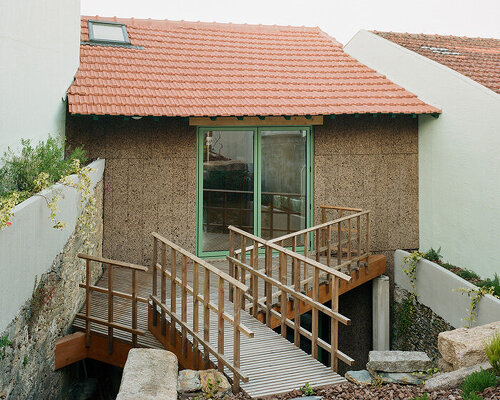atelier local turns residence upside down in Portugal
Architecture practice atelier local adapts a modest existing house into a more flexible and livable dwelling in Valongo, a small town near Porto, Portugal. The project, Valongo VII, keeps much of the original structure but arranges space in a different way. Instead of adding more volumes to the existing building, the architects choose to flip the typical domestic arrangement by placing bedrooms on the lower floor and relocating the main living area under the pitched roof, producing a house that is small in footprint but spatially generous.
The materials used remain pared down, relying on elements that are easy to read and maintain. Existing timber components are painted to create visual continuity and allow for future replacements to blend in over time. Outside, the cork facade is left exposed, its texture and tone grounding the building in its surroundings. At the rear, three octagonal concrete columns, cast using salvaged formwork, support a light wooden terrace that connects the interior to the garden. A rough concrete water tank anchors one edge of the outdoor space, while a mirrored wall reflects the planting, a layered composition by landscape studio pomo.
Though the house was originally conceived as a seasonal retreat, its final form suggests what the architects refer to as an ‘urban primitive hut,’ not in reference to an idealized past, but as a framework for inhabiting space with care.
all images by Francisco Ascensão
curved forms complete the ceiling of Valongo VII
The Valongo-based design team of atelier local worked with elements that were already there, such as stone walls, a timber roof and floor structure, and an old staircase along the party wall. All remaining features were preserved, repaired, or carefully adapted, except the staircase, which was removed due to its poor condition but whose original position guided the new internal layout.
On the lower level of Valongo VII, light partition walls define similarly sized bedrooms, each with its own direct access to a quiet courtyard. The entrance hall was also given special attention, with its complex geometry adding spatial interest and a sense of generosity for a house of this size.
Upstairs, the original attic becomes a high-ceilinged living space. The pitched roof, previously underused, now opens up long views and allows for cross-ventilation. A new structural beam supports the existing truss and makes room for a window placed high in the wall, bringing light inside. The ceiling is finished with plasterboard catenaries, curved forms shaped on-site that emerged during construction through hands-on experimentation in collaboration with the builders.
atelier local adapts a modest existing house into a more flexible and livable dwelling in Valongo
a mirrored wall reflects the planting, a layered composition by landscape studio pomo
three octagonal concrete columns support a light wooden terrace
the project keeps much of the original structure
instead of adding more volumes the architects choose to flip the typical domestic arrangement
relocating the main living area under the pitched roof
the original attic becomes a high-ceilinged living space
the ceiling is finished with plasterboard catenaries
the curved forms were shaped on-site
a house that is small in footprint but spatially generous
relying on elements that are easy to read and maintain
bedrooms are placed on the lower floor
the materials used remain pared down
existing timber components are painted to create visual continuity
project info:
name: Valongo VII
architect: atelier local | @atelier___local
location: Valongo, Portugal
design team: João Paupério, Maria Rebelo, Francisco Craveiro
landscape: pomo | @pomolandscapes
photographer: Francisco Ascensão | @francisco.ascensao
The post cork-clad house in portugal gets upside-down layout through atelier local’s redesign appeared first on designboom | architecture & design magazine.

